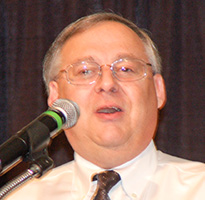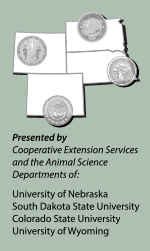Current Economic Picture
for the Cow-Calf Producer
by Kindra Gordon, Angus Journal field editor
RAPID CITY, S.D. (Dec. 3, 2013) — Jim Robb, director of the Livestock Marketing Information Center (LMIC), provided a candid snapshot of the global economic environment as he addressed producers and industry leaders attending the Range Beef Cow Symposium in Rapid City, S.D., Dec. 3.

Recognizing risks and high costs within the industry, Jim Robb emphasized that “mistakes are costly and sound business practices are required.”
Robb noted that world economic growth has changed dramatically and is now primarily being driven by the “developing” world as opposed to the “developed” world.
Here in the United States, Robb called it a “slow growth rate” for the economy.
“The average U.S. consumer today is poorer than they were in 2008 in spendable dollars,” he said. “That’s a concern for the beef industry.”
Regarding current beef demand, Robb noted that domestic per capita consumption is currently declining. Despite that, because of record-high beef prices, the demand picture has actually improved in the last several years.
In his view, he said, domestic consumer demand for beef should be OK. Meanwhile, foreign beef demand is currently relatively strong, but may struggle in the future.
Robb said he anticipates interest rates will head higher, but, he said, it will be a gradual increase, primarily affecting long-term (10- and 30-year rates), while short-term rates should stay stable.
“This is not the 1980s all over again,” he emphasized. “This is a different time.”
On the topic of corn, Robb noted that corn prices are down, but, he added, “They are not going to $2 per bushel.”
He also said, “The ethanol boom is over. It’s a mature industry and is no longer going to cause a shock in the industry that causes your feedstuff costs to skyrocket.”
That said, Robb stressed that price volatility will continue. Past events such as 9/11, BSE and the 2008 credit crisis should teach us that world events will cause market shocks to continue.
Recognizing the risks and high costs within the industry, he emphasized that “mistakes are costly and sound business practices are required.”
For 2014, Robb said the U.S. cattle inventory will be less than the 92.3 million head on inventory a year ago, but it will still be above 92 million head.
“We ain’t gonna run out of cattle,” he said. “We still produce the most beef in the world with fewer head.”
However, he said, the next several years will be telling and could be dramatically different in cattle numbers. He cited urbanization, shifts to crop production and fewer available grassland resources as some of the factors that will affect rebuilding the U.S. cow inventory. He added that the export market will be important to continue demand pull.
In his view it will likely be 2017 or later before we see a significant increase in U.S. beef product output, he concluded.
Robb spoke Tuesday at RBCS XXIII. Visit the Newsroom at www.rangebeefcow.com/2013 view his PowerPoint or listen to his presentation.
---------------------
The RBCS is a biennial educational symposium offering practical production management information. It is sponsored by the Cooperative Extension Service and animal science departments of the University of Wyoming, South Dakota State University, Colorado State University and the University of Nebraska.
Comprehensive coverage of the symposium is available online at www.rangebeefcow.com. Compiled by the Angus Journal editorial team, the site is made possible through sponsorship of LiveAuctions.tv and the cooperation of the host committee.
Editor’s Note: This article was written under contract or by staff of the Angus Journal. To request reprint permission and guidelines, contact Shauna Rose Hermel, editor, at 816-383-5270.


